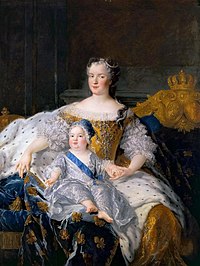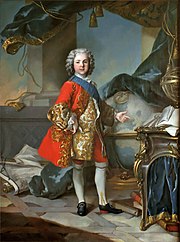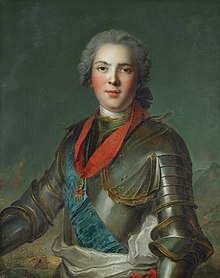Louis, Dauphin of France (1729–1765)
| Louis | |||||
|---|---|---|---|---|---|
| Dauphin of France | |||||
 Portrait by Anne-Baptiste Nivelon, 1764 | |||||
| Born | 4 September 1729 Palace of Versailles, Paris, France | ||||
| Died | 20 December 1765 (aged 36) Château de Fontainebleau, France | ||||
| Burial | |||||
| Spouses | |||||
| Issue more... | |||||
| |||||
| House | Bourbon | ||||
| Father | Louis XV | ||||
| Mother | Marie Leszczyńska | ||||
| Signature |  | ||||
Louis, Dauphin of France[1] (Louis Ferdinand; 4 September 1729 – 20 December 1765) was the elder and only surviving son of King Louis XV of France and his wife, Queen Marie Leszczyńska. As a son of the king, Louis was a fils de France. As heir apparent, he became Dauphin of France. Although he died before ascending to the throne himself, all three of his sons who made it to adulthood were to later rule France: Louis XVI (reign in 1774–1792), Louis XVIII (1814–1815, again in 1815–1824) and Charles X (1824–1830).
Early life and education
[edit]Louis's birth secured the throne and his mother's position at court, which previously had been precarious due to her giving birth to three daughters in a row before the birth of the Dauphin.[2] He had a younger brother, Philippe, who died as a toddler.[2][3]

Louis was baptised privately and without a name by Cardinal Armand de Rohan.[4] On 27 April 1737 when he was seven years old the public ceremony of the other baptismal rites took place. It was at this point that he was given the names Louis Ferdinand. His godparents were his cousin Louis, Duke of Orléans, and his great-grandaunt the Dowager Duchess of Bourbon.[3]
Louis's governess was Madame de Ventadour who had previously served as his father's governess.[2][5] When he was seven years old, the Duke of Châtillon was named his governor,[6] the Count of Muy was named under-governor, and Jean-François Boyer, formerly bishop of Mirepoix, was named preceptor.[3][7]


From an early age Louis took a great interest in the military arts.[8] He was bitterly disappointed when his father would not permit him to join the 1744 campaign in the War of the Austrian Succession.[9] When his father became deathly ill with fever at Metz, Louis disobeyed orders and went to his bedside, much to the king's resentment.[10][11] The incident resulted in the dismissal of Louis's beloved governor, the Duke of Châtillon.[12][13] Later, in 1745, Louis was able to accompany his father on his Flanders campaign[14] and witness the Battle of Fontenoy.[15][16][17] After Fontenoy, Louis was not allowed to participate in battles, in part due to the king's escalating jealousy and increasingly distant attitude toward his son.[18] He was very close and protective to his mother and sisters, especially Henriette.[19]
First marriage
[edit]In 1744 Louis XV negotiated a marriage between his fifteen-year-old son and the eighteen-year-old Infanta María Teresa Rafaela of Spain, daughter of King Philip V of Spain and his Italian wife, Elisabeth Farnese, and first cousin of Louis XV. The marriage contract was signed 13 December 1744; the marriage was celebrated by proxy in Madrid on 18 December 1744 and in person at Versailles on 23 February 1745.[20]


Louis and María Teresa Rafaela were well matched and had a real affection for each other. They had one daughter, Princess Marie Thérèse of France (19 July 1746 – 27 April 1748). Three days after the birth of their daughter, María Teresa Rafaela died on 22 July 1746.[21][22] Louis was only 16 years old. He grieved intensely at the loss of his wife,[23][24] but his responsibility to provide for the succession to the French crown required he marry again quickly.[25][26]
In 1746, Louis received the Order of the Golden Fleece from his father-in-law, King Philip V of Spain.[27]
Second marriage
[edit]On 10 January 1747, Louis was married by proxy in Dresden to Maria Josepha of Saxony, the fifteen-year-old younger daughter of Frederick Augustus II, Prince-Elector of Saxony and King of Poland,[28] and his wife Archduchess Maria Josepha of Austria. A second marriage ceremony took place in person at Versailles on 9 February 1747.[29][30]
Children
[edit]- Stillborn son (30 January 1748)
- Stillborn son (10 May 1749)
- Marie Zéphyrine of France (26 August 1750 – 1 September 1755); died in childhood.[31]
- Louis Joseph of France, Duke of Burgundy (13 September 1751 – 22 March 1761); died in childhood.
- Stillborn daughter (9 March 1752)
- Xavier of France, Duke of Aquitaine (8 September 1753 – 22 February 1754); died in infancy.
- Louis XVI of France (23 August 1754 – 21 January 1793); married Archduchess Maria Antonia of Austria, known as Marie Antoinette, and had issue.
- Louis XVIII of France (17 November 1755 – 16 September 1824); married Princess Marie Joséphine of Savoy, no issue.
- Stillborn son (1756)
- Charles X of France (9 October 1757 – 6 November 1836); married Princess Maria Theresa of Savoy and had issue.
- Marie Clotilde de France (23 September 1759 – 7 March 1802); married Charles Emmanuel IV of Sardinia, no issue.
- Stillborn son (1762)
- Élisabeth of France (3 May 1764 – 10 May 1794); died unmarried and without issue.

Personality
[edit]Louis was well educated:[32] a studious man,[33][34] cultivated, and a lover of music,[29][35] he preferred the pleasures of conversation to those of hunting,[36] balls, or spectacles.[37] With a keen sense of morality,[38] he was very much committed to his wife, Marie-Josèphe,[33] and disapproved of his father's mistresses.[39][40] Family friend Duke de Luynes and Abbe de Proyart noted in their memoirs that like his pious mother, Louis even at a young age,[41] donated much of his money in supporting various charitable causes for the poor which made him popular with the French populace.[42]
Very devout,[32][43] he was a fervent supporter of the Jesuits,[38][35][44] like his mother and sisters,[45][46] and was led by them to have a devotion to the Sacred Heart.[47] He appeared in the eyes of his sisters as the ideal of the Christian prince, in sharp contrast with their father, who was a notorious womanizer.
Later life and death
[edit]
Kept away from government affairs by his father,[48] Louis was at the center of the Dévots,[49] a group of religiously minded men who hoped to gain power when he succeeded to the throne.[50][51]
Louis died of tuberculosis at Fontainebleau in 1765 at the age of 36,[52] while his father was still alive, so he never became king of France.[53][54] His mother, Queen Marie Leszczyńska, and his maternal grandfather, the former king of Poland, Stanislaus I Leszczyński, Duke of Lorraine, also survived him. His eldest surviving son, Louis-Auguste, duc de Berry, became the new dauphin,[55][54] ascending the throne as Louis XVI at the death of Louis XV, in May 1774.[56]
Louis was buried in the Cathedral of Saint-Étienne in Sens[55] at the Monument to the Dauphin of France & Marie-Josephe of Saxony, designed and executed by Guillaume Coustou, the Younger. His heart was buried at Saint Denis Basilica next to his first wife.[57]
Ancestry
[edit]| Ancestors of Louis of France[58][59] | |||||||||||||||||||||||||||||||||||||||||||||||||||||||||||||||||||||||||||||||||||||||||||||||||||||||||||||||||||||||||||||||||||||||||||||||||||||||||||||||||||||||||||||||||||||||||||||||||||||||||||||||||||||||||||||||||||||||||||||||||||||||||||||||||||||||||||||||||||||||||
|---|---|---|---|---|---|---|---|---|---|---|---|---|---|---|---|---|---|---|---|---|---|---|---|---|---|---|---|---|---|---|---|---|---|---|---|---|---|---|---|---|---|---|---|---|---|---|---|---|---|---|---|---|---|---|---|---|---|---|---|---|---|---|---|---|---|---|---|---|---|---|---|---|---|---|---|---|---|---|---|---|---|---|---|---|---|---|---|---|---|---|---|---|---|---|---|---|---|---|---|---|---|---|---|---|---|---|---|---|---|---|---|---|---|---|---|---|---|---|---|---|---|---|---|---|---|---|---|---|---|---|---|---|---|---|---|---|---|---|---|---|---|---|---|---|---|---|---|---|---|---|---|---|---|---|---|---|---|---|---|---|---|---|---|---|---|---|---|---|---|---|---|---|---|---|---|---|---|---|---|---|---|---|---|---|---|---|---|---|---|---|---|---|---|---|---|---|---|---|---|---|---|---|---|---|---|---|---|---|---|---|---|---|---|---|---|---|---|---|---|---|---|---|---|---|---|---|---|---|---|---|---|---|---|---|---|---|---|---|---|---|---|---|---|---|---|---|---|---|---|---|---|---|---|---|---|---|---|---|---|---|---|---|---|---|---|---|---|---|---|---|---|---|---|---|---|---|---|---|---|---|---|
| |||||||||||||||||||||||||||||||||||||||||||||||||||||||||||||||||||||||||||||||||||||||||||||||||||||||||||||||||||||||||||||||||||||||||||||||||||||||||||||||||||||||||||||||||||||||||||||||||||||||||||||||||||||||||||||||||||||||||||||||||||||||||||||||||||||||||||||||||||||||||
References
[edit]- ^ He is called simply Louis by the most reputed biographies (including the earliest ones by Proyart and Rozoir), the major genealogical works about the House of Bourbon (including Achaintre and Dussieux) and numerous engravings. Several modern works (e.g. Antonia Fraser, Marie Antoinette) and some websites call him Louis Ferdinand to distinguish him from his father and his two sons.
- ^ a b c Bernier 1984, p. 68.
- ^ a b c "So, Just Who Was Louis Dauphin Of France", Salon Privé Magazine, August 31, 2021
- ^ Broglie 1877, p. 15.
- ^ Broglie 1877, pp. 15–16.
- ^ Broglie 1877, p. 21.
- ^ Broglie 1877, p. 22.
- ^ Broglie 1877, p. 36.
- ^ Bernier 1984, p. 122.
- ^ Bernier 1984, p. 129.
- ^ Broglie 1877, p. 56.
- ^ Broglie 1877, pp. 57–60.
- ^ Bernier 1984, p. 130.
- ^ Broglie 1877, p. 75.
- ^ Broglie 1877, p. 77.
- ^ Mitford 1976, pp. 38–45.
- ^ Haggard 1906, pp. 238–242.
- ^ Broglie 1877, pp. 122–123.
- ^ Broglie 1877, p. 38.
- ^ Bernier 1984, p. 133.
- ^ Algrant 2002, p. 59.
- ^ Broglie 1877, p. 98.
- ^ Mitford 1976, p. 57.
- ^ Algrant 2002, p. 60.
- ^ Bernier 1984, p. 145.
- ^ Mitford 1976, p. 77.
- ^ Nicolas-Louis Achaintre, Histoire généalogique et chronologique de la maison royale de Bourbon (Paris: Mansut, 1825), II, 149. T. F. Boettger says he received it in 1739.
- ^ Algrant 2002, pp. 62–63.
- ^ a b Cronin 1975, p. 23.
- ^ Algrant 2002, p. 68.
- ^ Spawforth, Tony (2008). Versailles: A Biography of a Place. New York: St. Martin's Press. pp. 200–201. ISBN 978-0-312-60346-5. OCLC 213451442.
- ^ a b Cronin 1975, p. 22.
- ^ a b Bernier 1984, p. 158.
- ^ Bernier 1984, pp. 151–152.
- ^ a b Bernier 1984, p. 159.
- ^ Haggard 1906, p. 176.
- ^ Mitford 1976, p. 79.
- ^ a b Perkins 1897, p. 255.
- ^ Bernier 1984, p. 147.
- ^ Haggard 1906, pp. 304–305.
- ^ Broglie 1877, p. 19.
- ^ Broglie 1877, p. 331.
- ^ Bernier 1984, p. 151.
- ^ Haggard 1906, pp. 347–348.
- ^ Bernier 1984, p. 214.
- ^ Mitford 1976, p. 119.
- ^ Cronin 1975, p. 35.
- ^ Cronin 1975, p. 26.
- ^ Jones 2003, p. 234.
- ^ Haggard 1906, p. 175-177.
- ^ Broglie 1877, pp. 187.
- ^ Algrant 2002, p. 299.
- ^ Bernier 1984, p. 220.
- ^ a b Perkins 1897, p. 256.
- ^ a b Cronin 1975, p. 40.
- ^ Cronin 1975, pp. 67–68.
- ^ Broglie 1877, pp. 333–334.
- ^ Genealogie ascendante jusqu'au quatrieme degre inclusivement de tous les Rois et Princes de maisons souveraines de l'Europe actuellement vivans [Genealogy up to the fourth degree inclusive of all the Kings and Princes of sovereign houses of Europe currently living] (in French). Bourdeaux: Frederic Guillaume Birnstiel. 1768. p. 12.
- ^ Żychliński, Teodor (1882). Złota księga szlachty polskiéj: Rocznik IVty (in Polish). Jarosław Leitgeber. p. 1. Retrieved 1 August 2018.
Sources
[edit]- Bernier, Olivier (1984). Louis the Beloved: the Life of Louis XV. New York: Doubleday. ISBN 978-0385184021.
- Broglie, Emmanuel de (1877). Le fils de Louis XV, Louis, dauphin de France, 1729-1765. E. Plon.
- Cronin, Vincent (1975). Louis and Antoinette. New York: William Morrow & Company, Inc.
- Haggard, Andrew (1906). The Real Louis the Fifteenth. London: Hutchinson. Retrieved 9 November 2023.
- Jones, Colin (2003). The Great Nation: France from Louis XV to Napoleon. New York: Penguin Books. ISBN 978-0140130935.
- Mitford, Nancy (1976). Madame de Pompadour. London: Sphere Books. Retrieved 8 November 2023.
- Perkins, James Breck (1897). France Under Louis XV.
- Algrant, Christine Pevitt (2002). Madame de Pompadour: Mistress of France. New York: Grove Press. ISBN 978-0802140357.
Further reading
[edit]- Dechêne, Abel, Le dauphin, fils de Louis XV. Paris: Librairie du dauphin, 1931.
- Ducaud-Bourget, François. Louis, dauphin de France: le fils du Bien-Aimé. Paris: Conquistador, 1961.
- Hours, Bernard. La vertu et le secret: le dauphin, fils de Louis XV. Paris: Champion, 2006.
- Huertas, Monique de, Marie-Josèphe de Saxe: mère de nos trois derniers rois de France et de Madame Élisabeth, Paris: Pygmalion, 1995.
- Latour, Louis Therese (1927). Princesses Ladies And Salonnieres of The Reign of Louis XV.
- Proyart, Liévin-Bonaventure. Vie du dauphin, père de Louis XVI, Lyon: Bruyset-Ponthus, 1788.
- Rozoir, Charles du, Le dauphin, fils de Louis XV et père de Louis XVI et de Louis XVIII, Paris: Eymery, 1815.
- Zieliński, Ryszard, Polka na francuskim tronie, Warszawa: Czytelnik, 1978.
External links
[edit]- De la Tour's pastels at the Musée l'Écuyer, Saint-Quentin, (in French) the pastel illustrated above described as a study for one of four portraits de la Tour made of the Dauphin (according to a letter of the Marquis de Marigny), of which the only known survivor, at the Louvre is dated 1748. The curators at the Musée l'Écuyer consider the study above to have served perhaps for the first of these portraits, that of 1745.
- 1729 births
- 1765 deaths
- 18th-century peers of France
- 18th-century French people
- People from Versailles
- French people of Polish descent
- Knights of the Golden Fleece of Spain
- 18th-century deaths from tuberculosis
- Heirs apparent who never acceded
- Tuberculosis deaths in France
- Princes of France (Bourbon)
- Dauphins of France
- Children of Louis XV
- Sons of kings


